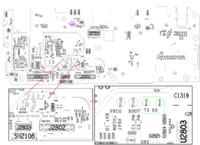Xiaomi Mi Pad 4 (xiaomi-clover): Difference between revisions
mNo edit summary |
mNo edit summary |
||
| Line 20: | Line 20: | ||
| status_touch = Y | | status_touch = Y | ||
| status_screen = Y | | status_screen = Y | ||
| status_wifi = N | | status_wifi = N | ||
| status_xwayland = Y | | status_xwayland = Y | ||
| Line 37: | Line 36: | ||
| status = booting | | status = booting | ||
| booting = yes | | booting = yes | ||
| pmoskernel = 6.7 | | pmoskernel = 6.7 | ||
}} | }} | ||
{{Based on SoC|Qualcomm_Snapdragon_660_(SDM660)|Snapdragon 660}} | {{Based on SoC|Qualcomm_Snapdragon_660_(SDM660)|Snapdragon 660}} | ||
Revision as of 19:12, 15 January 2024
 Mi Pad 4 running Sxmo | |
| Manufacturer | Xiaomi |
|---|---|
| Name | Mi Pad 4 |
| Codename | xiaomi-clover |
| Released | 2018 |
| Type | tablet |
| Hardware | |
| Chipset | Qualcomm Snapdragon 660 (SDM660) |
| CPU | 4x Qualcomm Kryo 260 Silver @ 1.8GHz + 4x Qualcomm Kryo 260 Gold @ 2.2GHz |
| GPU | Adreno 512 |
| Display | 1920x1200 IPS |
| Storage | 32GB |
| Memory | 3GB |
| Architecture | aarch64 |
| Software | |
| Original software | Android |
| Original version | 8 |
| postmarketOS | |
| Category | testing |
| Pre-built images | no |
| Mainline | yes |
| postmarketOS kernel | 6.7 |
| Flashing |
Works |
|---|---|
| USB Networking |
Works |
| Internal storage |
No data |
| SD card |
No data |
| Battery |
Works |
| Screen |
Works |
| Touchscreen |
Works |
| Multimedia | |
| 3D Acceleration |
Broken |
| Audio |
Broken |
| Camera |
Broken |
| Camera Flash |
No data |
| Connectivity | |
| WiFi |
Broken |
| Bluetooth |
Broken |
| GPS |
Broken |
| NFC |
No data |
| Modem | |
| Calls |
Broken |
| SMS |
Broken |
| Mobile data |
Broken |
| Miscellaneous | |
| FDE |
Broken |
| USB OTG |
No data |
| HDMI/DP |
No data |
| Sensors | |
| Accelerometer |
Broken |
| Magnetometer |
No data |
| Ambient Light |
No data |
| Proximity |
No data |
| Hall Effect |
No data |
| Haptics |
No data |
| Barometer |
No data |
| This device is based on the Snapdragon 660. See the SoC page for common tips, guides and troubleshooting steps |
There are 3 different variant to take note:
- WiFi only model (SDA660, 8 inch)
- LTE model (SDM660, 8 inch)
- Plus model with LTE (SDM660, 10 inch, different touch controller/display)
Contributors
- nergzd723
Users owning this device
- Alexeymin (Notes: Test subject #2. Mi Pad 4 PLUS actually)
- Anthony (Notes: Main goal - working kernel with all the hardware)
- Bczeman
- KenOokamiHoro (Notes: Running Pixel Experience 13)
- Kevinwidjaja21 (Notes: WiFi only model. Running crDroid. Dual boot PMOS through SD card.)
- Nergzd723 (Notes: mainline now)
How to enter flash mode
You have to press + to enter the bootloader.
Installation
In order to install postmarketOS the bootloader must be unlocked. Unlocking is done by following the official process provided by Xiaomi (read the FAQ for detailed instructions).
Follow Installation guide using pmbootstrap to build your own image.
1. Run pmbootstrap init and select xiaomi as vendor and clover as device.
2. Follow the onscreen instruction and configure as your needs.
Next, we will build the system:
$ pmbootstrap install
Flash the kernel and rootfs:
$ pmbootstrap flasher flash_kernel $ pmbootstrap flasher flash_rootfs --partition userdata
Installation to SD card
You can take advantage of Mi Pad 4's SD card slot to install postmarketOS for testing.
Install to the SD card:
$ pmbootstrap install --sdcard=/dev/sde
To boot from SD, with the device in fastboot mode (with device off, press Power + Volume Down until it enters fastboot mode), type:
$ pmbootstrap flasher boot
Note: This uses pmbootstrap from your computer to boot postmarketOS from the SD card without disturbing your bootloader or your system.
Additional information
UART pins location
See also
- pmaports!2003 Initial merge request
- Deviceinfo HW links: Mi Pad 4, Mi Pad 4 PLUS
